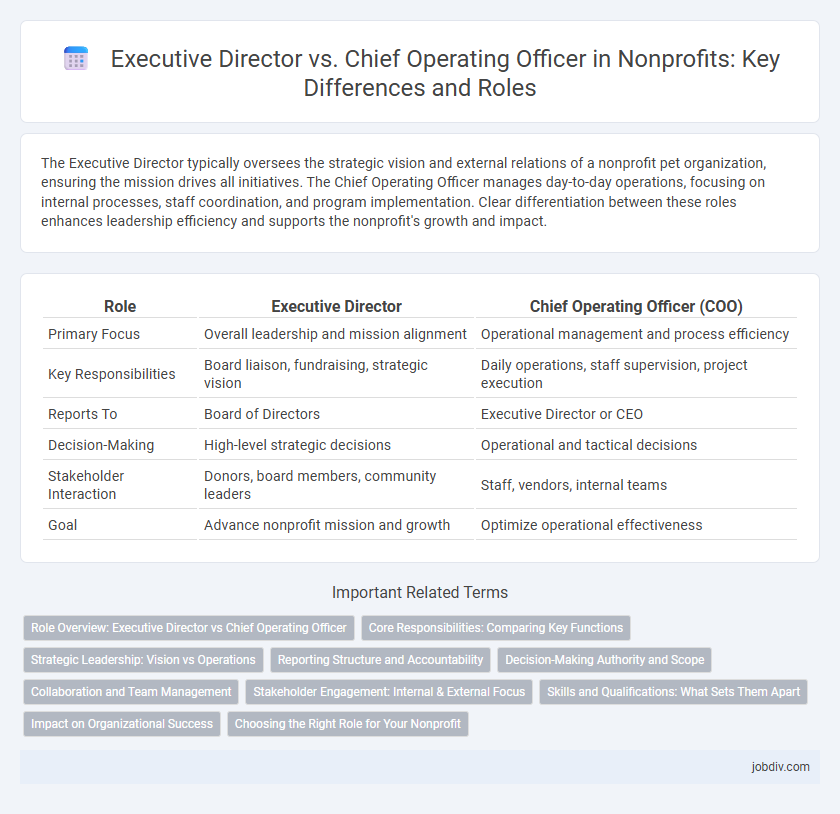The Executive Director typically oversees the strategic vision and external relations of a nonprofit pet organization, ensuring the mission drives all initiatives. The Chief Operating Officer manages day-to-day operations, focusing on internal processes, staff coordination, and program implementation. Clear differentiation between these roles enhances leadership efficiency and supports the nonprofit's growth and impact.
Table of Comparison
| Role | Executive Director | Chief Operating Officer (COO) |
|---|---|---|
| Primary Focus | Overall leadership and mission alignment | Operational management and process efficiency |
| Key Responsibilities | Board liaison, fundraising, strategic vision | Daily operations, staff supervision, project execution |
| Reports To | Board of Directors | Executive Director or CEO |
| Decision-Making | High-level strategic decisions | Operational and tactical decisions |
| Stakeholder Interaction | Donors, board members, community leaders | Staff, vendors, internal teams |
| Goal | Advance nonprofit mission and growth | Optimize operational effectiveness |
Role Overview: Executive Director vs Chief Operating Officer
The Executive Director in a nonprofit organization spearheads overall strategic vision, external relations, and fundraising efforts, ensuring alignment with the mission and board directives. The Chief Operating Officer manages day-to-day operations, oversees program implementation, and optimizes internal processes to enhance organizational efficiency and impact. Both roles collaborate closely to achieve sustainable growth and operational excellence within the nonprofit sector.
Core Responsibilities: Comparing Key Functions
The Executive Director oversees the nonprofit's overall strategic vision, board relations, and external partnerships, ensuring alignment with the mission and long-term goals. The Chief Operating Officer manages daily operations, internal processes, and staff coordination to optimize organizational efficiency and program delivery. While the Executive Director focuses on leadership and external engagement, the COO ensures operational execution and resource management.
Strategic Leadership: Vision vs Operations
The Executive Director primarily drives the nonprofit's strategic vision, setting long-term goals and fostering organizational mission alignment. The Chief Operating Officer focuses on operational execution, managing day-to-day activities to ensure efficient resource utilization and program delivery. Together, these roles balance visionary leadership with effective operational management, crucial for sustainable nonprofit growth.
Reporting Structure and Accountability
The Executive Director typically holds the highest leadership role in a nonprofit, directly accountable to the Board of Directors, overseeing overall strategy and organizational performance. The Chief Operating Officer reports to the Executive Director, managing daily operations, program implementation, and internal departments to ensure alignment with strategic goals. Clear reporting structures between these roles enhance accountability, operational efficiency, and effective governance within the nonprofit organization.
Decision-Making Authority and Scope
The Executive Director holds the highest decision-making authority within a nonprofit, overseeing strategic vision, board relations, and organizational leadership. The Chief Operating Officer manages daily operations, implementing policies and processes to achieve the Executive Director's strategic objectives. Decision-making scope for the Executive Director covers long-term goals and external partnerships, while the COO focuses on internal management and operational efficiency.
Collaboration and Team Management
The Executive Director and Chief Operating Officer work closely to drive nonprofit success through strategic collaboration and effective team management. While the Executive Director focuses on overall vision and external relations, the COO ensures operational efficiency and internal workflow optimization. Their partnership fosters a cohesive leadership dynamic that maximizes staff performance and advances organizational goals.
Stakeholder Engagement: Internal & External Focus
The Executive Director prioritizes external stakeholder engagement, building relationships with donors, board members, and community partners to advance the nonprofit's mission and secure resources. The Chief Operating Officer focuses on internal stakeholder engagement, fostering collaboration among staff, volunteers, and departments to ensure efficient operations and program delivery. Both roles are critical in maintaining alignment between external expectations and internal capabilities.
Skills and Qualifications: What Sets Them Apart
Executive Directors in nonprofits require strong leadership, strategic vision, and fundraising expertise to guide the organization's mission and build community partnerships. Chief Operating Officers focus on operational management, process optimization, and team supervision to ensure effective program delivery and administrative efficiency. While both roles demand financial acumen and excellent communication skills, the Executive Director drives external relations and organizational growth, whereas the COO emphasizes internal systems and day-to-day operations.
Impact on Organizational Success
Executive Directors shape a nonprofit's strategic vision and external relationships, driving mission alignment and fundraising success. Chief Operating Officers focus on internal management, optimizing operations, program delivery, and resource allocation for increased efficiency. Together, their collaboration directly influences organizational growth, sustainability, and overall impact on community services.
Choosing the Right Role for Your Nonprofit
Selecting the right leadership role for your nonprofit depends on the organization's size, mission complexity, and operational needs. An Executive Director typically serves as the primary visionary and external representative, focusing on fundraising, stakeholder relations, and strategic direction. The Chief Operating Officer handles daily operations, staff management, and internal systems, making this role crucial for nonprofits experiencing growth or requiring streamlined operational efficiency.
Executive Director vs Chief Operating Officer Infographic

 jobdiv.com
jobdiv.com